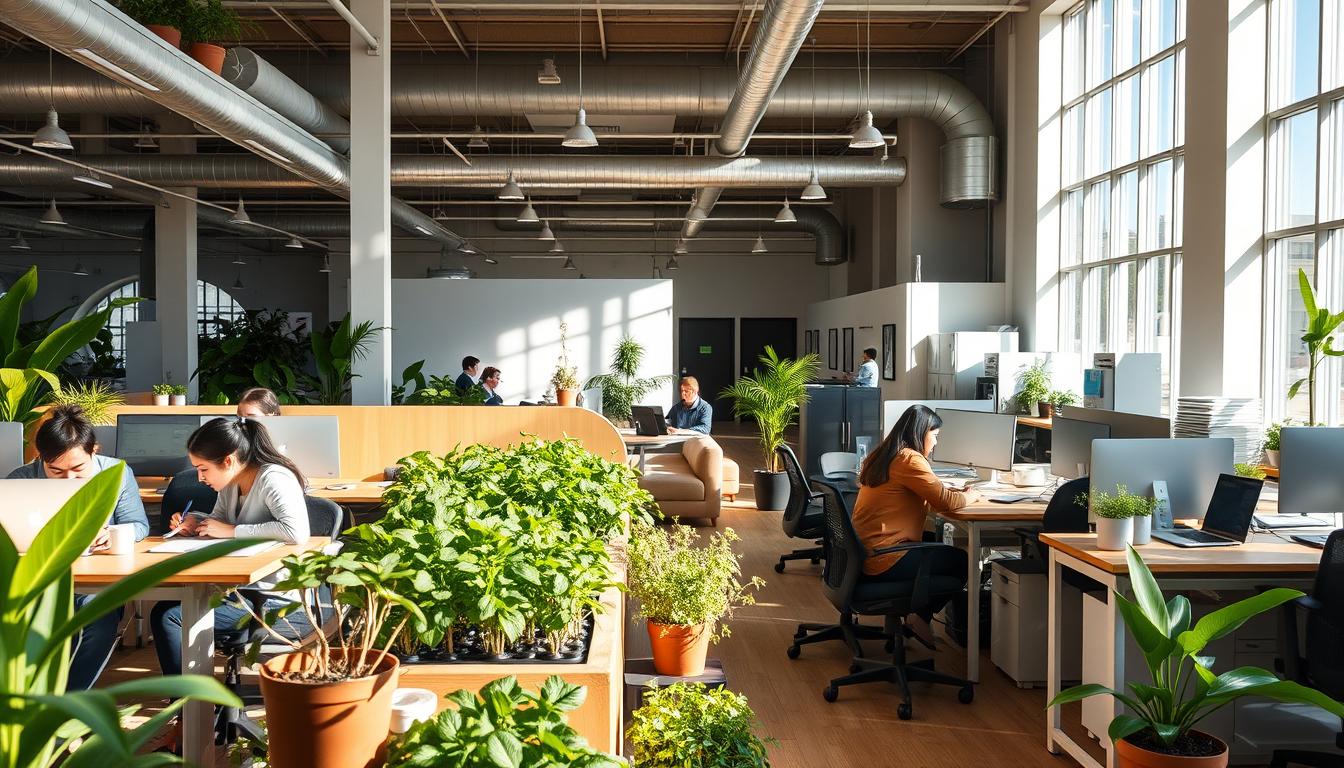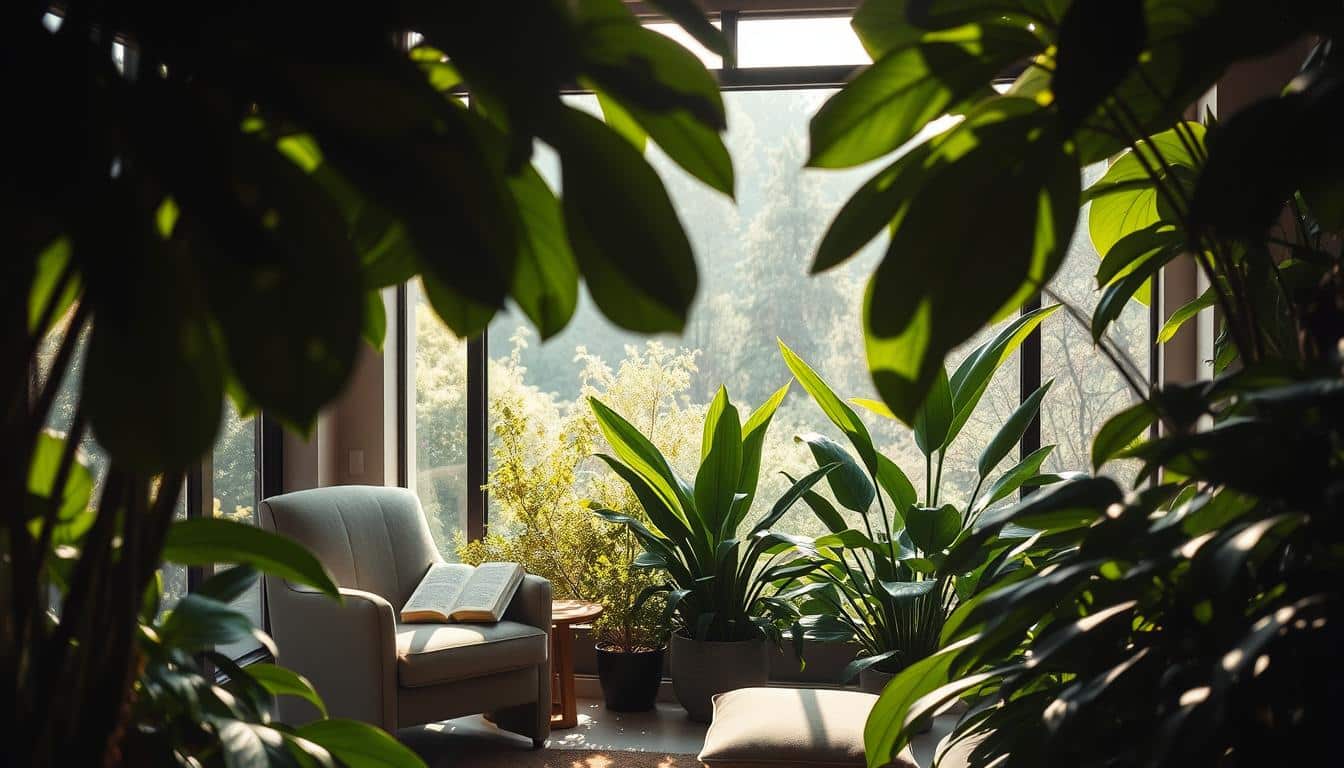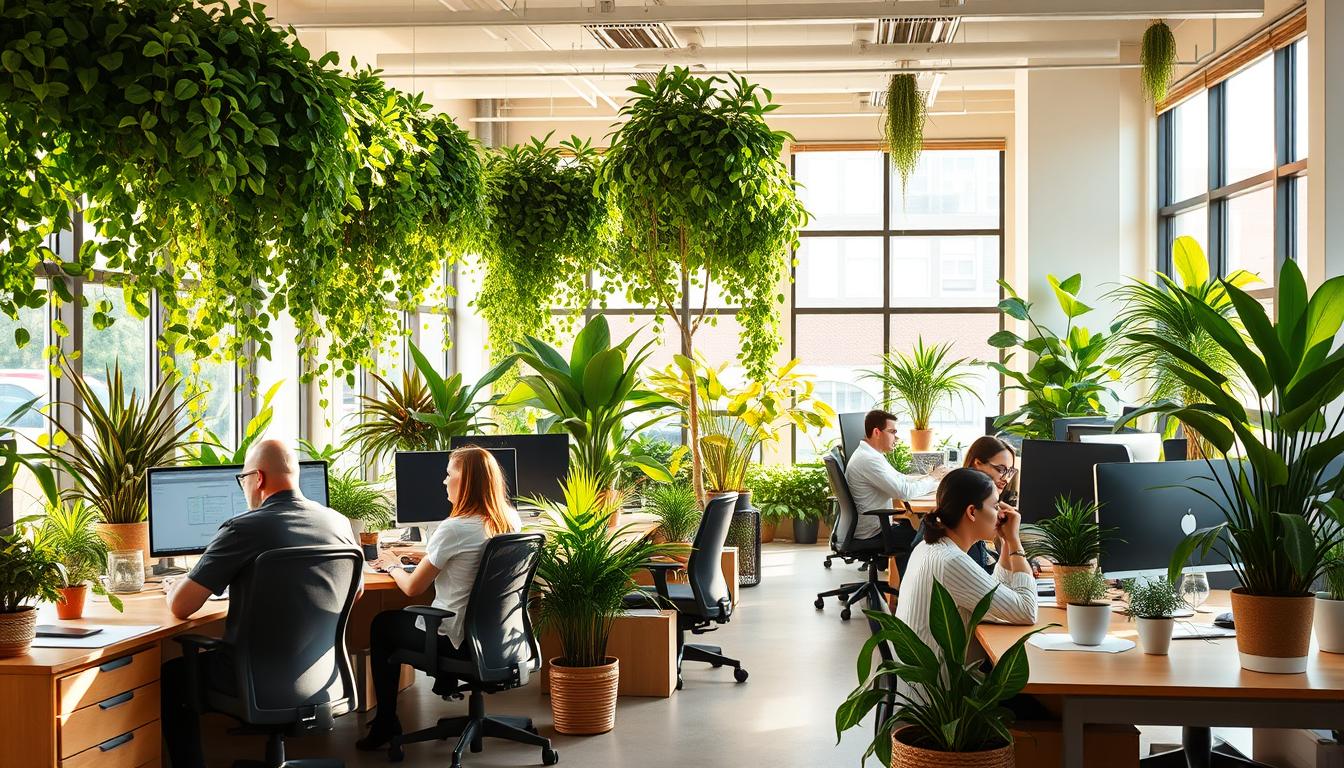Nowadays, we all work fast and hard. So, feeling mentally tired is common. Green offices help with this problem. They mix nature with our work spaces. This makes us feel better.
This guide explores how our work places can make us healthier. It shows that green offices help us work better and feel less tired. By adding nature to our offices, companies help us feel mentally well. They use smart design to make our work lives better.
Introduction to Mental Fatigue and Its Importance
Mental fatigue is a big issue in today’s workplaces. It comes from too much stress and makes people tired in their minds and emotions. Workers with mental fatigue have a hard time staying focused, which can make them less productive. Keeping mental health in check at work is really important. It helps employees feel good and helps the organization succeed.
It’s key to understand how mental fatigue affects people at work. The World Health Organization says that companies need to look after their employees’ mental health. They should fight workplace stress. This makes the work environment better. It makes employees happier and more productive.

Understanding Mental Fatigue in the Workplace
Mental fatigue touches many workers in different fields. It comes from work stress and not enough resources to do the job. Causes like long hours, tight deadlines, and dealing with office politics can tire employees. This can lead to burnout and hurt workplace mental health.
When employees don’t have what they need to meet demands, they feel stressed. This not only harms their health but also costs the company. Problems like more people missing work, less work done, and more staff leaving can happen.
Theories like Attention Restoration Theory (ART) and Stress Recovery Theory (SRT) show how our surroundings affect our mental fatigue. They say giving people time to recover their mental strength can make them work better. Making supportive workplaces can lessen the bad effects of mental fatigue.
The Impact of Green Offices on Employee Well-being
Green offices greatly improve how workers feel. Adding nature to workspaces helps everyone’s mental health. Being around greenery makes people more emotionally strong and less stressed.
This shows why it’s crucial to include natural features in office designs.
Connection Between Nature and Mental Health
Nature greatly affects our mental well-being. Studies reveal that being close to nature reduces anxiety and sadness. People in green offices feel calmer and more focused.
This proves nature is key to a healthier, more productive team.
Benefits of Biophilic Design in Offices
Biophilic design does more than just look good. It makes offices better places for sparking new ideas. Plants and sunlight create spaces where people can work better.
This approach not only improves the office look but also helps employees feel good.
Mental Fatigue Recovery in Green Offices
In today’s quick-paced work environment, it is crucial to create spaces that help with mental fatigue recovery. Effective green design strategies improve both productivity and employee well-being. Adding nature into the office helps build a healthy, stress-free environment.
Strategies for Implementing Green Design
Here are some methods to bring green design into office spaces:
- Access to Outdoor Areas: Set up areas for employees to relax, chat, or work outside. This helps lower mental fatigue and spark creativity.
- Incorporate Indoor Plants: Adding different plants improves air quality and looks nice. It creates a peaceful environment that supports mental rest.
- Enhance Natural Lighting: Use windows and skylights to bring in sunlight. It keeps everyone alert and positive.
- Improve Ventilation: Good airflow keeps the office fresh. It helps employees stay focused and productive.
Creating Restorative Work Environments
Building restorative work settings involves more than just looks. Studies show that certain design elements can aid in mental fatigue recovery:
- Nature Integration: Adding natural features like water or green walls makes an area more relaxing. It can help staff unwind.
- Flexible Workspaces: Spaces that allow for teamwork and alone time help employees refresh when they need it.
- Mindful Layouts: Designing clutter-free, organized spaces helps with concentration and calmness. This leads to better task focus.
Biophilic Design Elements to Reduce Stress
Using biophilic design in offices can really help reduce stress. It makes a big difference for employees when nature is part of the design. Both seeing nature and hearing it play a key role in making a place calming and good for mental rest.
Visual and Non-Visual Connections with Nature
Being able to see nature is vital for feeling good. For instance, windows that show green areas can make people feel better and more productive. Sounds from nature, like water features, also help in relaxing and lowering stress. Combining these sensory experiences is key to a healthy workspace.
Essential Features of Green Spaces
Studies show certain green space features really help reduce stress:
- Natural light boosts mood and energy.
- Variety in plants improves air and adds beauty.
- Water sounds help with calmness and relaxation.
Adding these design elements to offices turns them into peaceful places. It helps employees focus and feel better. People tend to have clearer minds and less stress at work when surrounded by nature.
The Role of Outdoor Spaces in Office Design
Adding outdoor spaces to office design has many benefits for employee well-being and work productivity. These areas give people a chance to connect with nature, which is a break from the busy office life. Green spaces not only improve the look of a workplace, but they also offer mental health perks. This supports a better approach to caring for mental well-being.
Access to Nature and Its Psychological Benefits
Having access to green spaces helps people recover from mental tiredness. Research shows that being outside lowers stress and makes people happier. This leads to better work engagement. Employees who take breaks outdoors keep their focus and creativity up all day. They feel more revived and less stressed, which helps in creating a positive work environment.
Benefits of Indoor Plants and Natural Elements
Adding indoor plants and natural elements to office spaces brings big benefits. Workers enjoy cleaner air and a more welcoming space. Green plants clear the air and make the office feel more natural and comfortable.
Improving Air Quality and Psychological Comfort
Indoor plants are great for making the air cleaner by taking in toxins and giving out oxygen. This clean air makes employees feel better mentally and more at ease. Seeing plants around can lower stress and make people feel good, helping them work better together and be more creative.
Increasing Productivity Through Natural Aesthetics
Bringing plants into the office design helps everyone do better work. A good-looking space can make employees feel more energetic and inspired. Research shows that offices with plants can improve focus and make workers happier with their jobs. This not only boosts output but also deepens their dedication to their work goals.
Strategies for Effective Breaks and Restorative Practices
Effective breaks are key to mental recovery and better focus at work. Short breaks, especially in nature, help employees feel fresh and more energetic. These moments also lower fatigue and stress, making people more productive.
Short Breaks in Nature and Mental Recovery
Studies show taking brief breaks outside is good for your brain. These outdoor moments refresh your mind, reducing tiredness. People feel clearer and more focused after spending time in nature, breaking the dullness of indoor work.
Structured Rest Periods to Enhance Focus
Planned breaks during the day boost focus. These breaks mean stepping away from the computer to relax and renew. Employers can suggest meditation, relaxing muscles, or going for a walk. These steps lower mental tiredness and make the team more productive and engaged.
Technology Integration in Promoting Green Spaces
Using tech in green design helps improve employees’ health in offices. Virtual reality allows for nature experiences, which is great for those in cities with few green spaces. Through virtual worlds, workers can feel like they’re outside, easing work stress.
Using Virtual Reality for Nature Experience
Virtual reality is changing how we connect with nature at work. It lets people enjoy nature’s mental perks. By using VR, workers can briefly “leave” their desks and feel refreshed. Integrating VR into the workplace includes:
- Creating immersive nature simulations that mimic real-world environments.
- Facilitating relaxation and mindfulness practices through virtual experiences.
- Providing opportunities for team-building activities in a virtual natural setting.
These methods use tech to make offices better. Virtual reality can lower stress and make everyone work better together.
Case Studies: Successful Green Office Implementations
Leading companies have switched to green office designs. This change has made their employees healthier and more productive. Green office examples show useful ways and clear benefits for better work life.
Examples from Leading Companies
Many organizations are proving that green offices make better workplaces. Let’s look at a few examples:
- Google: Their offices have lots of green spaces and nature-like features. This boosts creativity in their teams.
- Interface: They chose sustainable materials and designs inspired by nature. This led to happier staff and less turnover.
- LinkedIn: By adding living walls and natural light, focus and concentration have greatly improved.
Measuring the Impact on Employee Performance
To see how well their green efforts are doing, companies look at specific numbers. They particularly look at:
- Less time off because of stress and tiredness.
- Better productivity and work efficiency.
- Higher job happiness and people staying in their jobs longer.
These numbers help show that green offices help individuals and teams succeed. These real cases and results offer great tips for other companies to do the same.
Future Trends in Green Office Design
Green office design is evolving. It shows a strong commitment to sustainability and caring for employee well-being. Future trends will focus on mental health and being kind to the planet. Businesses are seeing the importance of green practices. They know these practices make better workplaces. This will change how our workplaces look in the future.
Sustainable Practices for Long-Term Mental Health
What’s new in green design:
- Incorporation of smart materials that adapt to environmental conditions.
- Implementation of energy-efficient technologies, promoting reduced carbon footprints.
- Flexibility in workspace design to cater to the evolving needs of employees.
Tomorrow’s trends do more than improve office spaces. They also look after mental health by fostering places for creativity, working together, and relaxation. As companies adopt these ideas, employees will enjoy better support. Workplaces will better meet their mental health needs.
Conclusion
Green designs in offices are key for helping minds reset and boosting employee happiness. This guide shows how nature and mental health are linked. It tells us green offices can lower stress and make productivity better.
By using biophilic design, companies can make spaces that help with mental strength. These spaces also help create a successful work environment.
Looking ahead, we need more research on green offices and mental health. Investing in green practices helps the planet and makes employees happier. Companies that follow these ideas can make their workplaces healthier and more satisfying.



